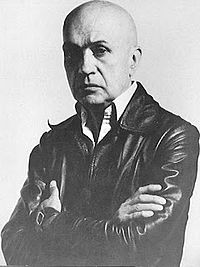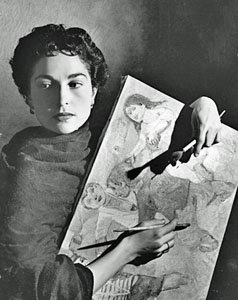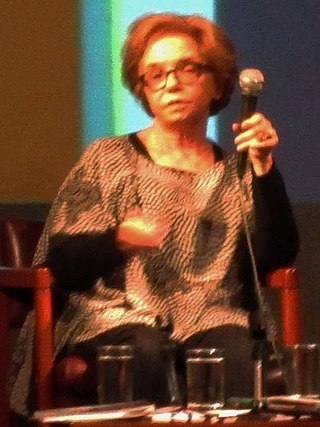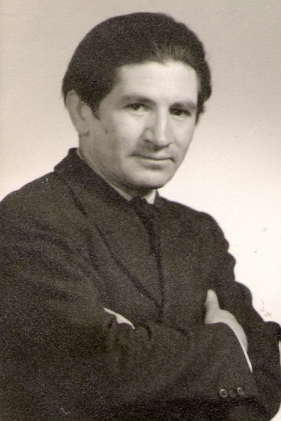
The Muisca are an Indigenous people and culture of the Altiplano Cundiboyacense, Colombia, that formed the Muisca Confederation before the Spanish conquest. The people spoke Muysccubun, a language of the Chibchan language family, also called Muysca and Mosca. They were encountered by conquistadors dispatched by the Spanish Empire in 1537 at the time of the conquest.

Édgar Negret Dueñas was a Colombian abstract sculptor.

Débora Arango Pérez was a Colombian artist, born in Medellín, Colombia as the daughter of Castor María Arango Díaz and Elvira Pérez. Though she was primarily a painter, Arango also worked in other media, such as ceramics and graphic art. Throughout her career, Arango used her artwork to explore many politically charged and controversial issues, her subjects ranging from nude women to the role of the Roman Catholic Church to dictatorships.

Central Cemetery of Bogotá is one of the main and most famous cemeteries in Colombia located in Bogotá. Houses several national heroes, poets and former Colombian presidents. It was opened in 1836 and was declared National Monument in 1984. Some of the sculptors of the mausoleums are Tenerani and Sighinolfi.
HJCK El Mundo en Bogotá is a Colombian cultural radio station, founded 15 September 1950 and based in Bogotá. HJCK became an online-only station in 2005.

Lina Dorado is a contemporary artist and filmmaker based in New York City noted for her multimedia work and travel photography, Lina Dorado has authored two books in bilingual editions: Doble Vista / Second Sight and Drawing Only, Solo Dibujo alongside her long-term collaborator: Luis Cantillo. Their book Doble Vista / Second Sight written by Dorado and photographs by both was acquired by the New York Public Library Museum of Modern Art in New York MOMA and the Whitney Museum for their Artists' Books Collection. In August 2018 her first feature film Pelucas y Rokanrol was theatrically released in Colombia, the film was directed by Mario Duarte and written by Mario Duarte and Lina Dorado.

Lucy Tejada Saenz was a Colombian contemporary painter. She is the sister of Hernando Tejada, another famous Colombian artist.

Francisco Antonio Cano was a very recognized Colombian painter, sculptor, writer, and engraver from Antioquia, who is famous for his works in which he portrays the cultural identity of the country and region. One of his best known works is Horizons, which depicts the beginning of the colonization of Antioquia (1913) that took place during the second half of the nineteenth and early twentieth centuries. He was a professor and director of the School of Fine Arts in Medellín and in Bogotá. And also a mentor of other famous Colombian artists, such as Pedro Nel Gómez, Sergio Trujillo Magnenat and Marco Tobón Mejía.

Fanny Sanín Sader is a Colombian born artist from Bogotá who resides in New York City. The daughter of Gabriel Sanín Tobón and Fanny Sader Guerra, she is best known for her paintings of abstract geometric forms and colors. She is considered to be part of the second generation of abstract artists from Colombia.

Rómulo Rozo Peña was a sculptor. Some authors confirm that he was born in Chiquinquirá, Boyacá. He lived a major part of his life in Mexico. He married Ana Krauss in Czechoslovakia and had three children: Rómulo, Gloria and Leticia. His second wife was Manuela Vera, yucateca, with whom he had two children: Marco Antonio and Gloria Antonia. Rozo is best known for his internationally recognized sculpture, Bachué, which influenced a generation of Colombian artists.

Huitaca or Xubchasgagua was a rebelling goddess in the religion of the Muisca. The Muisca and their confederation were a civilization who inhabited the Altiplano Cundiboyacense in the Andes. Huitaca has been described by the chroniclers Juan de Castellanos in his Elegías de varones ilustres de Indias, Lucas Fernández de Piedrahita and Pedro Simón.
Elisa Mújica Velásquez was a Colombian writer. She published novels, short stories, essays, books for children as well as interviews, book reviews and columns for local newspapers El Tiempo and El Espectador. She was a member of the Academia Colombiana de la Lengua and the Real Academia Española. In 2018 the award Premio Nacional de Narrativa Elisa Mújica was created in order to recognize the work of unpublished female authors and to honor her 100th birth anniversary.
Programar Televisión is Colombian programadora set up in 1983 by Juan Guillermo Ríos, the family of former President Alfonso López Michelsen headed by Felipe López Caballero, Inversiones Restrepo and the Castaño Valencia family. This programadora is remembered for producing the Noticiero de las 7 newscast.

Ana Mercedes Hoyos was a Colombian painter, sculptor and a pioneer in modern art in the country. In her half-century of artistic works, she garnered over seventeen awards of national and international recognition. Beginning her career in a Pop Art style which moved towards abstract, her trajectory moved toward cubism and realism as she explored light, color, sensuality and the bounty of her surroundings. Her reinterpretations of master painters led her to an exploration of Colombian multiculturalism, and her later works focused on Afro-Colombian and mestizo heritage within the Colombian landscape. Her works can be found in the permanent collections of the Fuji Art Museum in Tokyo; the Ibercaja Collection in Zaragoza, Spain; the Museum of Modern Art in Mexico City; the Nassau County Museum of Art of Roslyn Harbor, New York, as well as Juan Antonio Roda and museums in other Latin American cities. Her collection of archival materials on San Basilio de Palenque were donated to the United Nations University in Tokyo and the Smithsonian's National Museum of African American History and Culture.

Alicia Dussán de Reichel was a Colombian educator, who was one of the first students of ethnology in the country. For two decades, she was the only woman conducting archaeological and anthropological studies in the country. Her research focused on Colombia and the Caribbean and along with her husband, she founded the University of the Andes' Department of Anthropology. She occupied Chair 15 of the Colombian Academy of Exact, Physical and Natural Sciences until 2008 and was the only anthropologist to be a member during her tenure. In 2010, she was honored by the French Government with the designation of officer of the Ordre des Arts et des Lettres.

Beatriz González is a Colombian painter, sculptor, critic, curator and art historian. González is often associated with the Pop Art movement. She is best known for her bright and colorful paintings depicting life in Colombia during the war-torn period known as La Violencia.
Adriana Marmorek is a Colombian artist, exploring themes of desire through photography, video, installation and sculpture.

Nirma Zárate Mejía (1936–1999) was a Colombian artist, professor and researcher famously known for her abstract works. Zárate was born in Bogota, Colombia. She grew up in Colombia during World War II. The war had many implications on Colombian lifestyle and politics at the time. Colombia first supported the Axis powers and was in a constant state of shifting between its military powers and societal aspects due to U.S. intervention. Colombia finally shifted to supporting the allies after the Japanese attack on Pearl Harbor. During this time, Colombia was in a severe state of poverty where impoverished children roamed the streets in high numbers and were called gamines. During this time, discrimination and violence from police towards impoverished children were extremely high. Zárate experimented with different mediums and styles such as Abstract Art or Pop Art. Her first exhibition was as a student in Bogota and shortly after, she moved to the United States where she lived for four years. She settled in Washington where she was chosen by Union Panamericana De Washington to participate in an exhibition of great Colombian art. Later in her career, Zárate was one of the co-directors of "Taller 4 Rojo", a collective of Colombian artists interested in representing the political and social reality of Colombia. Her art during this period in her life turned shifted to more politically active art. She also taught at the Universidad Nacional de Colombia for many years. Zárate died in her hometown of Bogotá, in 1999, at the age of sixty-three.
Rosa Navarro Barandica, is a Colombian photographer and mixed-media artist.

Hernando Tejada Sáenz, was a Colombian painter and sculptor. His most well-known sculpture, El Gato del Río, is a famous landmark of Cali, Colombia.
















